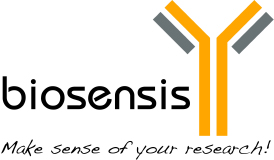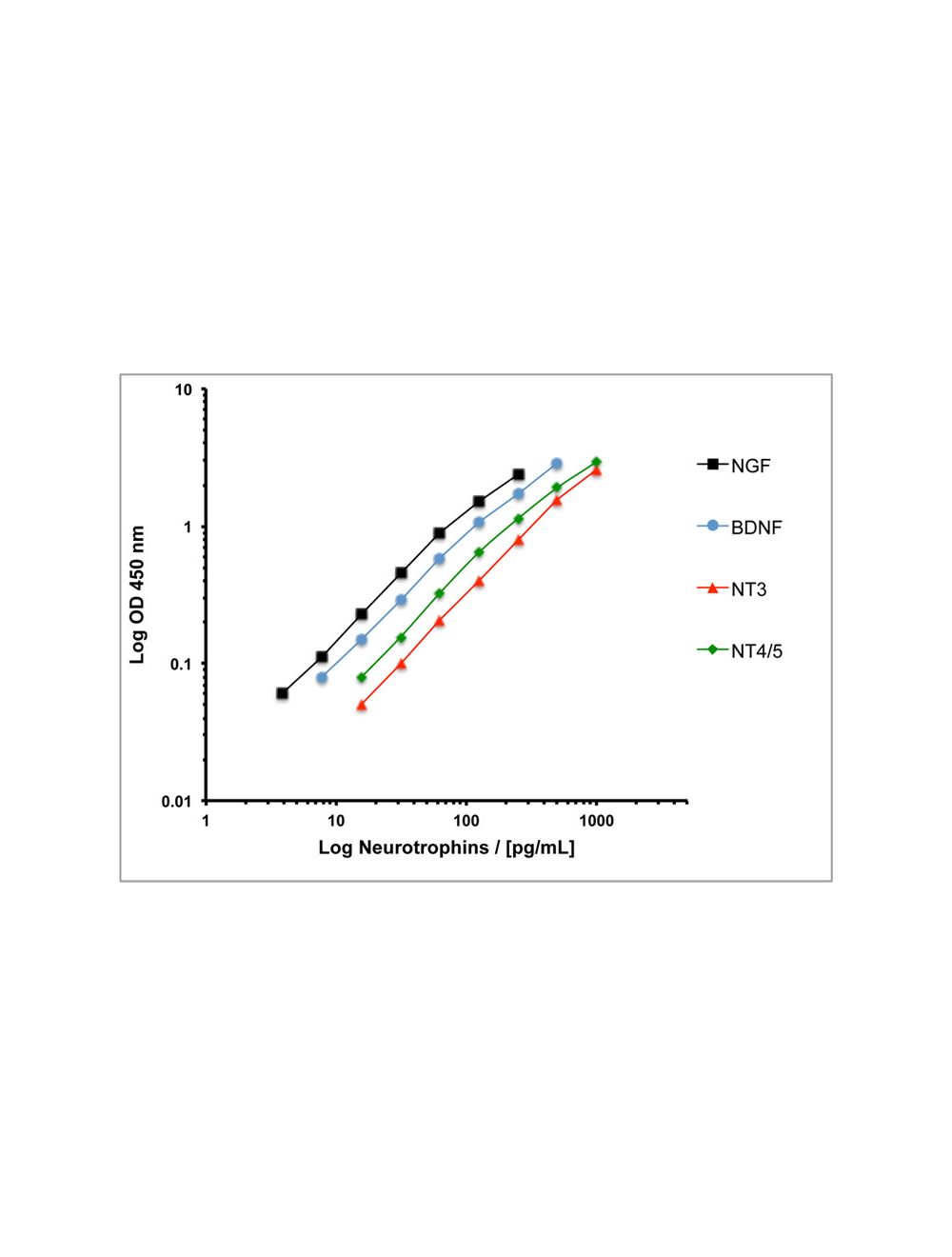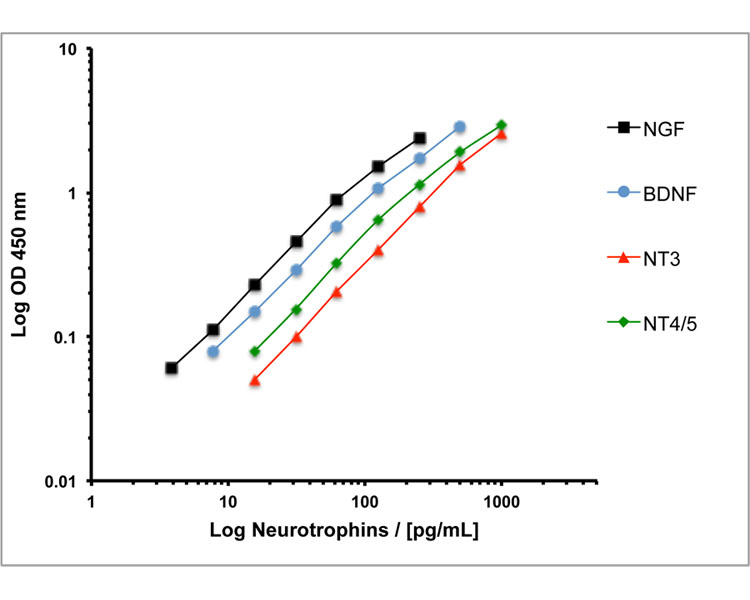Multi-Neurotrophin Screening, Mouse, Rapid™ ELISA assay
- Product Name Multi-Neurotrophin Screening, Mouse, Rapid™ ELISA assay
-
Product Description
The biosensis Multi-Neurotrophin RapidTM Screening ELISA kit has been designed to allow rapid screening and quantification of mouse NGF, BDNF, NT3 and NT4/5 in cell culture supernatants, lysates and brain extracts only if used as directed. Please refer to the kit protocol for specific use instructions for each substrate application.
This two-plate kit consists of four sets of 6 strips for each Neurotrophin, allowing for the assay of 16 samples per Neurotrophin tested and a full range of standards, all run in duplicate. It provides the identical sensitivities and ranges that are achieved in the complete, individual ELISA kits, thus allowing easy progression into the larger individual assay sizes when needed. The Multi-Neurotrophin RapidTM Screening ELISA kit therefore presents a cost effective way to quickly screen multiple samples, which can then be published or used prior to a more extensive analysis with the individual kits. The kit comes complete with all detection reagents and is ready to use. Individual coated strips are provided and each set of standards and detection antibodies are color-coded.
NOTE: For research use only. Not for diagnostic and clinical purposes. - Alternative Names NGF; BDNF; NT3; NT4/5;
- Application(s) ELISA
- Specificity This Multi-Neurotrophin Screening kit uses the same antibodies as in the individual Rapid ELISA kits. Each kit has been tested for cross-reactivity with other closely related neurotrophins and no cross-reactivity has been observed at 25 ng/mL of each neurotrophin tested. The antibodies used in this kit detect the human and rat form of each neurotrophin, but with varying efficiency depending on the target protein.
- Species Reactivity Mouse
- Immunogen Description As for individual ELISA kits
- Range NGF (3.9 - 250 pg/mL) BDNF (7.8 - 500 pg/mL) NT3 (15.6 - 1,000 pg/mL) NT4/5 (15.6 - 1,000 pg/mL)
- Sensitivity Typical LODs achieved based on 150% of background OD:NGF: 3 pg/mLBDNF: 1 pg/mLNT3: 4 pg/mLNT4/5: 30 pg/mL
- Regulatory Status For research use only.
Product Info
-
Product Description
The biosensis Multi-Neurotrophin RapidTM Screening ELISA kit has been designed to allow rapid screening and quantification of mouse NGF, BDNF, NT3 and NT4/5 in cell culture supernatants, lysates and brain extracts only if used as directed. Please refer to the kit protocol for specific use instructions for each substrate application.
This two-plate kit consists of four sets of 6 strips for each Neurotrophin, allowing for the assay of 16 samples per Neurotrophin tested and a full range of standards, all run in duplicate. It provides the identical sensitivities and ranges that are achieved in the complete, individual ELISA kits, thus allowing easy progression into the larger individual assay sizes when needed. The Multi-Neurotrophin RapidTM Screening ELISA kit therefore presents a cost effective way to quickly screen multiple samples, which can then be published or used prior to a more extensive analysis with the individual kits. The kit comes complete with all detection reagents and is ready to use. Individual coated strips are provided and each set of standards and detection antibodies are color-coded.
NOTE: For research use only. Not for diagnostic and clinical purposes. -
Related Products
Brain-derived neurotrophic factor, mature (BDNF, mature), Human, Mouse, Rat, Rapid™ ELISA assay
Nerve growth factor (Beta-NGF), Mouse, Rapid™ ELISA assay
Neurotrophin-4/5 (NT-4/5), Human, Mouse, Rat, Monkey, Rapid™ ELISA assay
Neurotrophin-3 (NT-3), Human, Mouse, Rat, Rapid™ ELISA assay
- Application(s) ELISA
- Application Details ELISA. For the quantification of Multi-Neurotrophin Screening in Culture Supernatant, Cell Lysates, Tissue Homogenates. Please download the detailed product insert for complete instructions for the successful use of this ELISA. Use only as directed.
- Target Multi-Neurotrophin Screening
- Specificity This Multi-Neurotrophin Screening kit uses the same antibodies as in the individual Rapid ELISA kits. Each kit has been tested for cross-reactivity with other closely related neurotrophins and no cross-reactivity has been observed at 25 ng/mL of each neurotrophin tested. The antibodies used in this kit detect the human and rat form of each neurotrophin, but with varying efficiency depending on the target protein.
- Target Host Species Mouse
- Species Reactivity Mouse
- Immunogen Description As for individual ELISA kits
- Range NGF (3.9 - 250 pg/mL) BDNF (7.8 - 500 pg/mL) NT3 (15.6 - 1,000 pg/mL) NT4/5 (15.6 - 1,000 pg/mL)
- Sensitivity Typical LODs achieved based on 150% of background OD:NGF: 3 pg/mLBDNF: 1 pg/mLNT3: 4 pg/mLNT4/5: 30 pg/mL
- Sample Type Cell Lysates, Culture Supernatant, Tissue Homogenates
- Detection Method Colorimetric
- Kit Components The ELISA kit box contains 96-well pre-coated strip plate(s) (6 strips/48 wells per neurotrophin target), protein standards, detection reagents, wash and sample buffers, substrate buffer and detailed protocols.
- Storage Instructions Store at 2-8°C
- Storage Temperature 2-8°C
- Batch Number Please see item label.
- Expiration Date 12 months from purchase.
- Alternative Names NGF; BDNF; NT3; NT4/5;
- Uniprot Number P21237; P01139; P20181; Q80VU4
-
Uniprot Number/Name
P21237 (BDNF_MOUSE)
P01139 (NGF_MOUSE)
P20181 (NTF3_MOUSE)
Q80VU4 (NTF4_MOUSE) - Scientific Background The Neurotrophin family of growth factors in all mammals including human has four members including Nerve Growth Factor (NGF), Brain-Derived Neurotrophic Factor (BDNF), Neurotrophin 3 (NT3) and Neurotrophin 4/5 (NT4/5). These are all essential to brain development, maturation and adult function, particularly for cell differentiation, survival, death and synaptic regulation.
- Shipping Statement For order quantities larger than 1 plate, this product is supplied in package units of 2 plates.
- Shipping Temperature 2-8°C (on cold packs)
- UNSPSC CODE 41116158
- Regulatory Status For research use only.
Specifications
-
Specific References
Yao R et al. (2024) FNDC5/irisin medicated the protective effects of Innovative theta-shaking exercise on mouse memory HELIYON [Open Access]. Application: Brain tissue homogenate
Steinke I et al. (2023) Selective PPAR-Delta/PPAR-Gamma Activation Improves Cognition in a Model of Alzheimer’s Disease Cells. 12(8), 1116. Application: Brain tissue homogenate
de Dios C et al. (2023) Inflammasome activation under high cholesterol load triggers a protective microglial phenotype while promoting neuronal pyroptosis Transl Neurodegener. 12(1):10. Application: Mouse cell culture supernantant
Kawanokuchi J et al. (2021) Acupuncture Treatment for Social Defeat Stress. Front Behav Neurosci. 15:685433. Application: Brain homogenate.
Takagishi S et al. (2021) Protein nanoparticles modified with PDGF-B as a novel therapy after acute cerebral infarction. eNeuro. [Epub ahead of print]. Application: Brain homogenate.
Leitao L et al. (2020) Osteoblasts are inherently programmed to repel sensory innervation. Bone Res. 8:20. Application: Culture supernatant.
Yamada K et al. (2020) The impact of ovariectomy on olfactory neuron regeneration in mice. Chem Senses. [Epub ahead of print]. Application: Mouse olfactory bulb homogenate.
Hutson TH et al. (2019) Cbp-dependent histone acetylation mediates axon regeneration induced by environmental enrichment in rodent spinal cord injury models. Sci Transl Med. 11(487). Application: Rodent DRG lysates.
Miura-Yura E et al. (2019) Secreted factors from cultured dental pulp stem cells promoted neurite outgrowth of dorsal root ganglion neurons and ameliorated neural functions in streptozotocin-induced diabetic mice. J Diabetes Investig. [Epub ahead of print]. Application: Conditioned medium of stem cells from human exfoliated deciduous teeth.
Noda T et al. (2019) Effects of Tokishakuyakusan on regeneration of murine olfactory neurons in vivo and in vitro. Chem Senses. [Epub ahead of print]. Application: Mouse olfactory bulb homogenate.

 1800 605-5127
1800 605-5127 +61 (0)8 8352 7711
+61 (0)8 8352 7711

